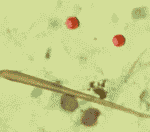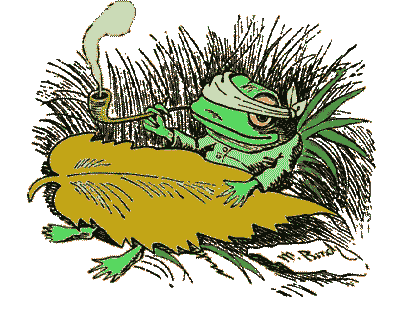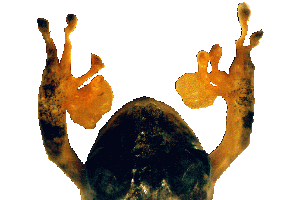Amphibian´s welfare
Table of contents:
- P3.1Working Group Microbiology of the DAPTF-Austria
- P3.2Infectious diseases in amphibians
- P3.3Opportunists
- P3.4Amphibians as Vector
- •Amphibians as Intermediate Hosts
- •Amphibians as Carriers of Potentially Pathogenic Microorganisms
- •Amphibian Breeding as the Source of Infections
- P3.5My adequate publications
- P3.6External adequate publications
P3.1 Working Group Microbiology of the DAPTF-Austria
The Declining Amphibian Population Task Force (DAPTF) was established in 1991 by the Species Survival Commission (SSC) as a loose network of more than 3.000 scientists all over the world. The mission of the DAPTF is to determine the nature, extent and causes of declines of amphibians throughout the world, and to promote means by which declines can be halted or reversed. Dr. Britta Grillitsch initiated in the last days of February 1997 a working group called DAPTF Working Group for Austria, for the purpose of promoting knowledge on amphibians in Austria. cit. Sticht [1997]. This DAPTF Working Group for Austria was patronized by the Austrian Herpetological Society (ÖGH). I was invited to join this working group and brought in my expertise on infectious microorganisms and infectious diseases of indigenous amphibians. Since this subject-specific cooperation was already raised before the founding of the Micro-Biology Consult Dr. Andreas Hassl, the initiating DAPTF-Austria-Working Group however collapsed in 1998, and unfortunately neither me nor the other members of the Working Group were able to raise any interest on this issue within the employing universities, this research project is organisationally and financially without an incorporation into a legal person. There has been no trace of the international branch of the DAPTF since 2004. Nevertheless, I continue to pursue the project with limited intensity. Till 29.10.25, 26 publications with 11,59 individualized Impact Points (iIP) were written by me on this topic and a value of 232 587 was created.
P3.2 Infectious diseases in amphibians
Amphibian populations are said to be declining on a world wide range. There now appears to be a growing body of public evidence to verify such declines, and probably even several extinction events within the last decades. Over the years, many hypotheses, such as habitat loss, the introduction of predators, global climate change, acid rain, and other effects of environmental pollution, have been proposed as explanations for these observations. However, until very recently infectious diseases have not been discussed in this context. One reason may be, that the introduction of foreign pathogens has not been generally accepted as an anthropogenic threat to the natural balance of an ecosystem.
Fig. 1: A convalescent frog.
cit. W. Busch.
Although wild-living amphibians have undoubtedly carried, suffered from, and died of unknown and unreported infectious diseases for as long as there have been wild amphibians, these infectious diseases are most probably the crucial factor within the scope of the recent worldwide decline of amphibian populations. Various demographic and nutritional changes in amphibian populations adapted to man combined with complacency about the role of opportunistic infectious diseases in general have brought about an increase in infectious diseases. In particular, waterborne diseases have increased in both human and animal communities in recent years. Thus challenges arise to the microbiology that are unprecedented in recent times. The amphibian population decline underscores the importance of understanding the interrelationship among stress, immune function, and susceptibility to disease. Especially the infectious diseases known as opportunistic diseases have been implicated as the proximal cause of death in several amphibian populations. Regarding macroclimate changes we have to state, that almost all declining populations are located in more or less cold to moderate localities such as the mountain ranges in the Western United State. But, because montane populations have lived for generations in cold or changeable temperatures and climatic changes are not unusual at all, it is unlikely that a single climatic change is the causative factor in the widespread appearance of "new" infectious diseases. Cold itself, even slow adaption to cold, seems to immunocompromise anura as their normal physiological response, characterized by lymphopenia and low complement activities. Maybe, whether-induced immunosuppression may also act synergistically with some new, presumably man-made, environmental or mental stress. Thus, the final immunosuppression can be a consequence of a variety of noxious environmental factors. It especially affects the cellular immune response by unfavourably changing the vitality of the cells involved. For amphibians, immunological parameters have been mainly investigated in Xenopus laevis Daudin, 1802. But, since the Xenopus frog is the only cold-blooded vertebrate known to have three immunoglobulin isotypes (IgM, IgY, IgX), and it's immune system is fundamentally similar to that of mammals (eg the rearrangement of T-cell receptor and Immunoglobulin genes, MHC class-I- and class-II-restricted T-cell recognition), it might not be an ideal model to study immunology in amphibians. For other species however, there is a deficiency of basic knowledge which is fundamentally necessary to assess the significance of immunosuppression in the genesis of infectious diseases in amphibians.
Unfortunately, our knowledge of the aetiology and pathogenesis of infectious diseases of amphibians is very poor, and knowledge of the effects of such diseases on population dynamics is poorer still. To confound matters, increasing doubt arises as to the scientific validity of traditional microbiological methods used and, more particularly, of the significance of the results reported for past investigations of infectious diseases caused by pathogens now known as opportunistic pathogens. The Microbiology Working Group of the late DAPTF Austria, therefore, gave emphasis to immunoregulatory mechanisms in indigenous amphibians and captured exotic ones, will investigate the influence of captivity on the health status, and will carry out epidemiologic studies on amphibians on fungi, gut and blood parasites, mycobacteria and other opportunistic bacteria.
P3.3 Opportunists

Fig. 2: Two Cryptosporidia in a frog´s feces.
© A. Hassl.
My special interest is focusing on a registration and balancing of mostly opportunistic behaving infectious pathogens associated with amphibian keeping. The microbiology and the hygienic problems of the interface man - exotic pet (amphibian) - feeder animal - terrarium is of a special interest of mine. The microbiological fauna of this interface is characterised by the appearance of a special type of infectious pathogens, so called "opportunistic pathogens". These ill-defined group of microorganisms do usually not infect or infest the host, but may cause even lethal disease in an immunologically debilitated animal or man, in rare cases even in amphibians and man mutually. There is a good characterisation of this type of pathogens by Karasawa et al. [2002] concerning Cryptosporidium sp. (Apicomplexa, Cryptosporidiidae) in Crotalus durissus Linnaeus, 1758 (Serpentes, Viperidae). In that case the difference in the host taxon doesn't make too much difference to the situation of opportunistic pathogens in amphibians: "The literature shows that elimination of oocysts in the feces is periodic, explaining the presence or absence of oocysts in samples from the same animal. The presence of Cryptosporidium sp. can be frequently associated with capture or recent import, suggesting that stress and altered immunological state can play an important role in the development of the infection. Cryptosporidiosis is selflimited in immunocompetent mammals and a life threat in immunosuppressed mammals, and this seems to also be true for reptiles. The elimination of environmental or nutritional problems and other diseases seems to be more effective than the use of anti-Cryptosporidium drugs to reduce the infection."
Some of the today acknowledged members of the group of opportunistic pathogens in amphibians are (text in red: taxa potentially pathogenic to man):
- Iridoviruses (eg Bohle IV),
- Aeromonas hydrophila (Chester, 1901),
- Pseudomonas sp.,
- Weeksella virosa Holmes et al., 1987,
- Salmonella enterica Le Minor & Popoff, 1987 and Salmonella enterica subsp. arizonae,
- Chlamydophila psittaci Everett et al., 1999,
- Chlamydophila pneumonia Everett et al., 1999,
- Mycobacterium fortuitum Da Costa Cruz, 1938 biovar peregrinus,
- Saprolegnia parasitica Coker, 1923,
- Basidiobolus ranarum Eidam, 1886 = B. haptosporus,
- Batrachochytrium dendrobatidis Longcore, Pessier & Nichols, 1999,
- Blastocystis sp.,
- Glugea sp.,
- Plistophora sp.,
- Myxosporida,
- numerous intestinal protozoa, previously known as "Flagellata",
- Opalina spp.,
- Trichodina spp.
- Rhabdias sp. ? (R. bufonis (Schrank, 1788)),
- Hannemania spp.
Fig. 3: Finger cysts colonised by Weeksella.
© A. Hassl.
An example of the impact of an infection of a frog with such an opportunistic bacterium, Weeksella virosa, is shown on the left side. These aerobic, gram negative, Pseudomonas-related rods are ubiquitous soil and water inhabiting bacteria which are known to be opportunistically infectious to immunosuppressed or traumatised vertebrates in which they lead to sepsis. Weeksella is apparently able to colonise cysts and, probably, to form necrotic foci in the epithelium of otherwise apparently healthy anurans. cit. Hassl et al. [2002]. The intention of the research work is the creation of recommendations on hygiene for manipulations of amphibians in special regard to the prevention of man-made infectious diseases in amphibians.
P3.4 Amphibians as Vectors
When thinking about a possible link between human health and amphibians, cases in which people were harmed by poison excreted through these animals' skin, by touching or coming into contact with a wound, immediately come to mind. There is, however, another frequently overlooked aspect of amphibian impact on the health of human beings: certain taxa of this group of animals can serve as intermediate hosts for pathogenic pathogens, and can transport these pathogens or cause contact between man and infectious foci.
Amphibians as Intermediate Hosts
The most severe and most dangerous illness that humans can contract from a pathogen transmitted by amphibians is an infection caused by the larvae of the tapeworm genus Spirometra. These parasites are located in the muscles of frogs as outwardly undifferentiated worm larvae. They can actively move into human tissue if direct contact occurs, stay there permanently, perhaps even metastasize, move, and increase in size to several cubic centimetres. Especially in South East Asia, where direct contact with frog meat is quite common, since compresses containing amphibian meat are used as an antibiotic remedy and placed on patients' eyes or on festering wounds. Particularly serious cases of these sparganoses (infestations with plerocercoids of the genus Spirometra) may lead to the loss of one's eyes; in minor cases, surgery is required to remove the worm. The development of a mature tapeworm in human beings is impossible.
Amphibians as Carriers of Potentially Pathogenic Microorganisms
Several potentially pathogenic bacteria have such a low host specificity and are so widespread that they can be found in sick amphibians as well as in sick humans. These include Aeromonas hydrophila (red leg, sepsis), Pseuolomonas sp., and Salmonella (diarrhea, sepsis). Contrary to the situation with reptiles, an actual transmission of these pathogens from amphibians to humans has not been proven until now. Nevertheless, caution is advised when dealing with excrement or in treating wounds.
Amphibian Breeding as the Source of Infections
In cases where human beings keep amphibians, it is inevitable that the caretakers come into contact with a special flora of microorganisms, specific to aquaterraria. The human pathogenic microorganisms of this flora include Mycobacterium fortuitum (but not M. ranae and M. xenopi!), some free-living, potentially pathogenic amoeba like Acanthamoeba spp., Naegleria fowleri Carter, 1970; a microorganism that produces brain abcesses) and the pathogen that causes a subcutaneous mycosis in Africa, Basidiobolus ranarum. So far, there are no basic scientific studies in existence concerning the health risk to humans in handling amphibians. Also, the risk to the animals during their first contact with humans, when microorganism exchange and "microorganism adaptation" occurs, has not been examined, although this phenomenon has a significant impact on physiological studies and on their chances of survival in captivity. Rectified cit. Hassl [1998].
P3.5 Eigene Publikationen, zum Thema passend
- A039 Hassl A, Hassl D [1988]: Ein Coccidium im Blut von Rana perezi (Seoane, 1885). Salamandra 24: 75–76.
- A063 Hassl A [1991]: Eine asymptomatische Kryptosporidien (Apicomplexa: Coccidia)-Infektion bei Agalychnis callidryas (Cope, 1862) (Anura: Hylidae). Herpetozoa 4: 127–131.
- Grillitsch B, Hassl A, Grillitsch H [1997]: Homepages: Declining Amphibian Population Task Force Austrian Working Group: Mikrobiologie http://www vu-Wienac at/i125/daptf/index.htm. 2 pp.
- A137 Hassl A [1998]: Krankheiten und Krankheitsabwehr. In: Hofrichter R (Hsg.): Amphibien. Naturbuch Verlag; Augsburg:108–110.
- Appelt S, Benyr G, Hassl A, Rotter M [2000]: Salmonellen in Terrarien mit aquatischen und semiaquatischen Lebensräumen. 27. Jahrestagung der Österr Ges Hyg Mikrobiol Präventivmed. 23.-25.05.2000; Goldegg, A. Poster 30.
- A167a Appelt S, Benyr G, Hassl A, Rotter M [2000]: Salmonellen in Terrarien mit aquatischen und semiaquatischen Lebensräumen. 27. Jahrestagung der Österr Ges Hyg Mikrobiol Präventivmed. 23.-25.05.2000; Goldegg, A. abstract P30.
- A170 Hassl A, Benyr G, Appelt A [2000]: Salmonellen - Infestationen in Terrarientieren. 34. Jahrestagung der Österr Ges Tropenmed Parasitol. 16.-18.11.2000; Wien, A. abstract.
- Hassl A [2000]: Diseases and Immunology. In: R. Hofrichter (edt): The Encyclopedia of Amphibians: Evolution, Anatomy and Physiology. Key Porter Books; Toronto, CA: 108–110.
- A186 Hassl A [2000]: Diseases and Defense Mechanisms. In: R. Hofrichter (edt): Amphibians: The world of frogs, toads, salamanders and newts. Firefly Books Ltd; Westport, CT: 108–110.
- A177 Hassl A, Benyr G, Sommer R [2001]: Occurrence of Cryptosporidium sp. oocysts in fecal and water samples in Austria. Acta Tropica 80/2: 145–149.
- p-cry Hassl A, Benyr G, Sommer R [2001]: Occurrence of Cryptosporidium sp. oocysts in faecal and water samples in Austria. 11th International Congress of Protozoology. 15.-19.07.2001; Salzburg, A. Poster.
- Oe01 Hassl A, Pfleger S, Benyr G [2001]: Salmonellen-Infestationen in Amphibien und Reptilien. Mitt Österr Ges Tropenmed Parasitol 23: 39–42.
- He14 Hassl A, Url A, Rebel-Bauder B [2002]: Weeksella virosa Holmes et al., 1987 colonised epidermal cysts in Hyla crepitans Wied-Neuwied, 1824 (Anura: Hylidae). Herpetozoa 14(3/4): 127–131.
- IJH1 Pfleger S, Benyr G, Sommer R, Hassl A [2003]: Pattern of Salmonella Excretion in Amphibians and Reptiles in a Vivarium. Int J Hyg Environ Health 206: 53–59.
- wi15 Hassl A, Benyr G [2003]: Hygienic evaluation of terraria inhabitated by amphibians and reptiles: cryptosporidia, free-living amebas, salmonella. Wiener Klinische Wochenschrift 115 (suppl 3): 68–71.
- wi16 Hassl A [2004]: Microbiological Conservation Medicine and Exotic Pets. Wiener Klinische Wochenschrift 116 (suppl 4): 53–57.
- s-rk1 Hassl A [2004]: Unterlagen zur Informationsveranstaltung Amphibien- und Reptilienhaltung im Österreichischen Rechtsbestand. Skriptum zur Fortbildungsveranstaltung. Eigenverlag; Wien, A. 37 pp.
- A224 Hassl A [2007]: Pet Amphibian Keeping in Central Europe: Underestimated Contagious Hobby. International Meeting on Emerging Diseases and Surveillance. Wien, A. abstract 11.009.
- p-am Hassl A [2007]: Pet Amphibian Keeping in Central Europe: Underestimated Contagious Hobby. International Meeting on Emerging Diseases and Surveillance. Wien, A. Poster 11.009.
- A228 Hassl A [2008]: Heim-Amphibien als potentielle Zoonosequellen. 27. Arbeitstagung der AG Amphibien- & Reptilienkrankheiten der Deut Ges Herpetol Terrarienk. 05.-06.05.2007; Detmold, D. Zusammenfassungen.
- A253 Hassl A [2010]: A case of a facultative life-cycle diversification in the fluke Pleurogenoides sp. (Lecithodendriidae, Plagiorchiida). Wiener Klinische Wochenschrift 122 (suppl 3): 91–93.
- A265a Hassl A, Kleewein A [2011]: Identifying hosts and host's answers to the enigmatic autochthonous leech Haemopis elegans (Hirudinea: Haemopidae). 5th Congress of the Slovenian Microbiological Society. 12.-15.10.2011; Maribor, SLO. abstractbook: 221.
- slo11 Hassl A, Kleewein A [2011]: Identifying hosts and host's answers to the enigmatic autochthonous leech Haemopis elegans (Hirudinea: Haemopidae). 5th Congress of the Slovenian Microbiological Society. 12.-15.10.2011; Maribor, SLO. Poster 95.
- A267 Hassl A, Kleewein A [2011]: Conservation Medicine's Ward: Haemopis elegans, an enigmatic toad-injuring autochthonous leech. 2nd Retreat of the Center for Pathophysiology, Infectiology and Immunology. 27.09.2011; Wien, A. Programme & Abstracts 26.
- 2-ret Hassl A, Kleewein A [2011]: A Conservation Medicine's Ward: Haemopis elegans, an enigmatic toad-injuring autochthonous leech. 2nd Retreat of the Center for Pathophysiology, Infectiology and Immunology. 27.09.2011; Wien, A. Poster.
- A314 Hassl A [2019]: Die Parasiten zentraleuropäischer, frei-lebender Bergmolche. ÖGH-Aktuell 50: 14–18.
P3.6 External adequate publications
- Karasawa ASM, daSilva RJ, Mascarini LM, Barrella TH, Lopes CAD [2002]: Occurrence of Cryptosporidium (Apicomplexa, Cryptosporidiidae) in Crotalus durissus terrificus (Serpentes, Viperidae) in Brazil. Memorias Do Instituto Oswaldo Cruz 97(6): 779–81.
- Sticht S [1997]: Von Lurchen und Menschen: Eine Geschichte über die rätselhaften Rückgänge von Amphibienpopulationen. Stapfia 51: 251–70.
 Andreas R. Hassl
Andreas R. Hassl

